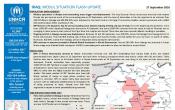Iraq
Operation: Iraq
Location
{"longitude":43,"latitude":33,"zoom_level":0}
Latest update of camps and office locations 13 Jan 2016. By clicking on the icons on the map, additional information is displayed.
Key Figures
| 2015 end-year results | |
| 500,000 | IDPs were provided with shelter support |
| 220,000 | IDP families were reached with basic domestic items, including seasonal assistance |
| 26,000 | families were targeted with multi-purpose cash assistance |
| 7,000 | Syrian refugee families were provided with core relief items, including special summerization and winterization kits |
| 96,000 | displaced persons benefited from UNHCR legal assistance and services |
| 2016 planning figures | |
| 100% | of Syrian refugees registered on an individual basis |
| 85% | of Syrian refugees receiving legal assistance |
| 20% | of IDP families targeted to receive support to secure long-term/permanent shelter |
Latest Updates and Related Links
People of Concern
18%
Increase in
2015
2015
| 2015 | 4,746,105 |
| 2014 | 4,026,863 |
| 2013 | 1,450,568 |

[["Refugees",277701],["Asylum-seekers",7420],["IDPs",4403287],["Returned IDPs",1747],["Returned refugees",5921],["Stateless",50000],["Others of concern",29]]
Loading ...
Budgets and Expenditure for Iraq
< Back
2015
{"categories":[2012,2013,2014,2015,2016],"budget":[231.49871145,293.72933672,564.26129787,556.06492208,549.94595405],"expenditure":[123.34774626,188.35476498,311.98260697,266.34543259,null]}
{"categories":[2012,2013,2014,2015,2016],"p1":[70.95823974,182.85293216,162.76932396,136.09662109,119.48767369],"p2":[1.10203691,1.32216338,2.00000074,2.0459884,0.80424081],"p3":[29.91426377,27.30414868,39.59885527,35.76378805,26.70785472],"p4":[129.52417103,82.2500925,359.8931179,382.15852454,402.94618483]}
{"categories":[2012,2013,2014,2015,2016],"p1":[33.307784,131.81378143,109.08450058,102.03521415,null],"p2":[0.26050327,0.42206457,1.96887166,1.499491,null],"p3":[22.86569699,14.49497183,10.53576239,11.32961956,null],"p4":[66.913762,41.62394715,190.39347234,151.48110788,null]}
Loading ...
CHOOSE A YEAR
- 2014
- 2015
- 2016
Working environment
- Armed conflict continued to cause internal displacement and generated humanitarian needs across the country. The fall of Ramadi in May 2015 resulted in significant levels of new displacement, mostly in Anbar Governorate.
- The financial crisis deeply affected the Kurdistan Region of Iraq (KRI) and undermined the capacity of the authorities to maintain basic services in locations with high concentrations of internally displaced people (IDPs), notably Dahuk, Baghdad, Kirkuk and Sulaimaniyah Governorates.
- While possibilities for return arose after the retaking of Baiji, Ramadi, Sinjar and Tikrit by government forces, continued volatility and challenges relating to stabilization and reconstruction hindered sustainable return.
- Implementation of protection activities was strained by the unstable security situation, particularly in Anbar, Ninewa, and Salah alDin Governorates.
Population trends
- Some 3.2 million people have been internally displaced since January 2014.
- Over 244,000 Syrian refugees were registered by the end of 2015, with 97 per cent residing in the KRI.
- Some 90 per cent of IDPs and more than 60 per cent of refugees reside outside of camps.
- More than 43,000 refugees and asylum-seekers of nationality other than Syrian and an estimated 50,000 stateless persons were registered in Iraq by the end of 2015.
Achievements and impact
- Coordination remained effective between line ministries, United Nations agencies and NGOs.
- Cash assistance was the preferred way of providing humanitarian assistance to the most vulnerable refugees and IDPs.
- UNHCR increased the emphasis on mainstreaming age, gender and diversity methodology into all programmes.
Unmet needs
- Due to the funding shortfall, approximately 63 per cent of assessed IDP shelter needs were unmet.
- Cash assistance was provided to some 6 per cent of the Syrian refugee population (some 3,200 Syrian families).
- Many refugee teachers stopped working due to non-payment of their government salaries, while prospects for self-reliance diminished with reduced job opportunities and higher competition for positions available to the refugee population.
Working environment
The escalation of armed conflict across the central governorates of Iraq, and the constantly changing security situation, have resulted in new and secondary movements of internally displaced people (IDPs) across central Iraq and the Kurdistan Region of Iraq (KR-I).UNHCR’s access to some IDP and refugee locations (particularly in central Iraq), as well as the ability of IDPs and refugees to transit through certain areas of Iraq, will likely remain restricted.
Newly displaced people in Iraq find their limited financial resources quickly depleted by the increasing costs of accommodation and basic foods.
The number of Iraqis seeking refuge in other countries is rising considerably; however, it is anticipated that the Syrian refugee population currently in Iraq will probably remain at a similar level or increase slightly, depending on developments in the northeastern part of the Syrian Arab Republic (Syria).
The central Government and KR-I authorities have contributed to the IDP and Syrian refugee response with: registration, core relief item (CRI) distribution, cash assistance, essential services in collective centres, and land allocation and site preparation for camps.
Needs and strategies
Since the 2015 plan and corresponding comprehensive budget for the Iraq operation were drawn up (mid-2014), the situation in the country has changed significantly. In 2015, the total population of concern to UNHCR is likely to exceed 3 million people. While UNHCR will remain engaged with all populations of concern, the programme will mainly be oriented towards the protection of refugees. The Office will continue to take the lead in coordinating the humanitarian response for all refugee populations.The Office will also continue its engagement in the IDP situation within the framework of the inter-agency cluster approach, leading three designated clusters, namely protection, camp coordination and camp management (CCCM), and shelter/non-food items (NFIs). It will advocate the Government of Iraq, UN Country Team and other actors fulfil their respective responsibilities with regard to IDPs, particularly for those displaced before the recent crises in 2014.
UNHCR’s strategy in Iraq will continue to focus on working together with the Government, other humanitarian stakeholders and donors to provide protection and durable solutions for people of concern. The main areas for attention will be to advocate and promote legal and protection interventions, deliver basic assistance and support to newly displaced people and longstanding IDP populations, as well as to build the capacity of governmental and national nongovernmental partners.





